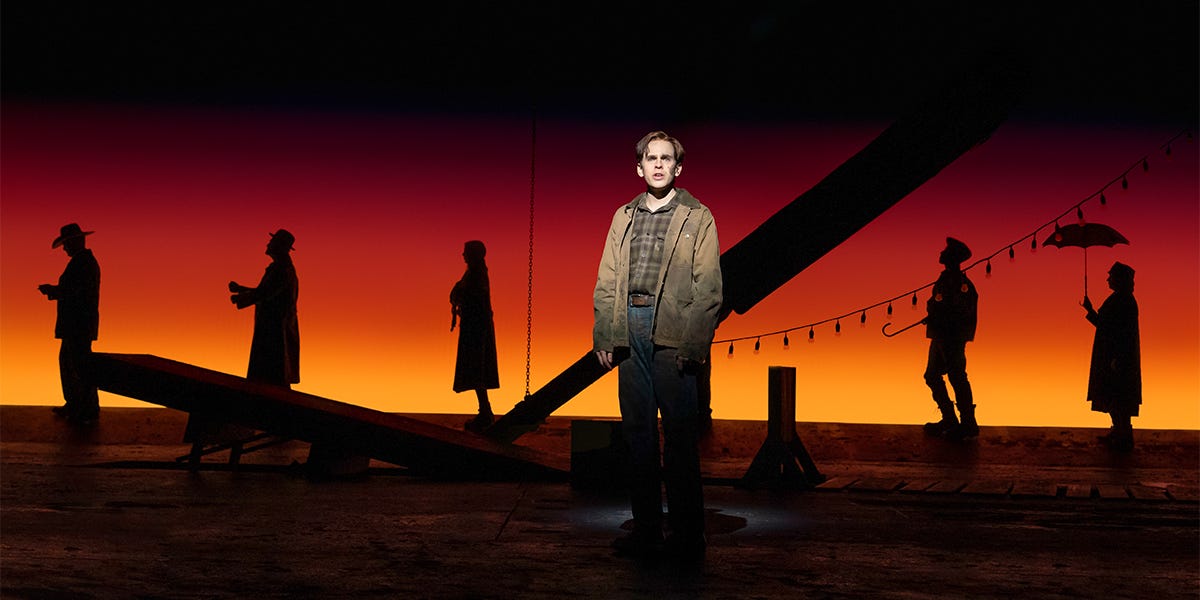Floyd Collins was an actual cave explorer who, in 1925, descended into Sand Cave in Kentucky, exploring the cave to be a public attraction. A musical about him, “Floyd Collins,” showing at Lincoln Center Theater on Broadway, tells the compelling tale of his ambition and downfall with a terrific score, creative storytelling, and strong performances.
It begins as he descends, dreaming in song about what he might call the attraction, what souvenirs he’ll sell, and the riches he’ll make, solving his family’s money problems and making his father proud. This sequence is the first of many examples of director Tina Landau’s elegant staging, brilliant in its simplicity. She sends Jeremy Jordan, as Floyd, scrambling on set pieces you can barely see around him.
Lit by designer Scott Zielinski with just a follow-spot, it feels like Floyd is in a pitch-black cave. Singing all the while, he descends into a large cavern, where he can’t quite see, but sounds out the space with a yodel that echoes back to him from speakers at the rear of the theatre. Exceptional sound design from Dan Moses Schreier creates the cave sonically while also giving the illusion of unamplified voices—the performers’ words sound like they’re coming directly from them.
Floyd’s adventurous joy is quickly cut short when some rocks fall and pin his legs (conveyed entirely through a sound cue). The rest of the show focuses on the two-week rescue operation and ensuing media circus that develops above ground.
Landau’s book effectively brings to life a large cast of distinct characters: Floyd’s father, stepmother, sister, and brother (the terrific Jason Gotay, who sings beautifully); three locals from the town; an outsider engineer who takes charge of the rescue effort; and a local reporter who is able to squeeze into the cave and becomes invested in Floyd’s rescue (an earnest Taylor Trensch).
Jordan, in a Tony-worthy performance, tracks the explorer’s passage from bold optimism, as he athletically explores the cave, to growing despair as he remains stuck for days. Pinned down for much of the show, Jordan conveys emotion powerfully using only his voice.
The first act has limited physical movement. Here we meet the characters as they discuss the situation and try (and fail) to rescue Floyd. The drama of Floyd’s predicament doesn’t fully land until the second act, when everyone’s assuredness of his rescue begins to fray, their blind optimism running up against the reality of the situation. Now the show becomes more dramatic and the staging grander, especially during a scene showing a carnival that has been set up as part of the media circus. As Floyd sings to himself below ground, he provides scoring for what’s happening above: masses have gathered to watch the rescue. Vendors roll out concessions stands, actors carry on giant bouquets of balloons, and they all join in a lovely dance (dance sequences by Jon Rua). It’s the same gawking we saw in the show “Dead Outlaw,” and the same entrepreneurial impulse to make money off of people’s curiosity. The contrast of the party atmosphere above and despair below further accentuates Floyd’s plight.

The Vivian Beaumont’s stage is already big, and here the set designer (the collective dots) does nothing to make it smaller—on the contrary, the stage is thrust out even farther into the audience than usual. Landau’s direction is a return to the essentials of theatre-making: showing us through actors’ movements and lighting where the underground cave is versus the aboveground world. Scenes in the cave pitch the stage into mostly darkness; while above-ground scenes include a large light wall at the rear that portrays gradients of color, each scene’s emotional tenor calibrated just right.
It's refreshing to encounter theatre that is non-literal, instead asking the audience to co-create the scene with our imagination. Floyd rises from his rocky prison several times, showing physically what he’s imagining, such as a scene with his brother reminiscing about their younger days, banding about the stage and recalling their joy. When at the song’s conclusion he is still stuck, his current situation feels that much more awful.
Adam Guettel’s lush score includes more repeated melodies than his also beautiful scores for “Days of Wine and Roses” and “The Light in the Piazza.” Its sound is folk-inspired, flecked with bluegrass, and elevated by gorgeous harmonica. The orchestra sounds terrific under Ted Sperling’s music direction. I can’t think of another show that includes yodeling—it’s sonically interesting, works melodically, and conveys meaning. In the beginning, Floyd imagines his yodel’s echoes as his future customers, answering his call to come into the cave. Once he is trapped, his yodeling seems like an exercise in self-affirmation: if I can hear myself echo back to me, I must still be here.
Originally produced nearly thirty years ago, the show gained a cult following based on a recording of the score; this production marks its Broadway premiere. It’s a beautiful work of art that may not have had commercial producing interest—perfect for the non-profit Lincoln Center to produce. It’s not for everyone: devoid of gimmicks, it demands concentration but rewards its audience well, as the gorgeous score and complex character-driven plot unfold at a steady pace, providing breathing room to consider the themes and ideas it raises.
Towards the end, a gorgeous dream ballet has Floyd imagining the cave attraction becoming reality, and the full cast, dressed all in white, come out to see the glorious thing he's made. The scene ends in a stunning tableau: the cast fanned out across the vast stage, looking at Floyd and appreciating his grand attraction. That it’s only a dream doesn’t diminish its glory, and the tragic, psychological journey of its protagonist makes this musical just as glorious.
Floyd Collins: Playing through June 22 at Lincoln Center Theatre. 2hr 30 min, including one intermission. Disclosure: At the performance I attended, understudy Kevin Bernard played the role of Floyd’s father, Lee Collins.
See you at the theatre!








